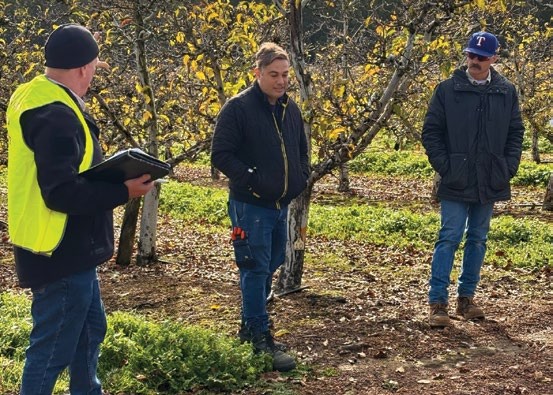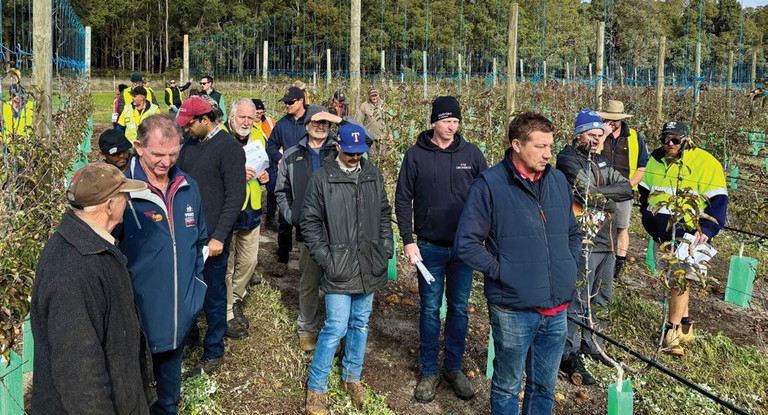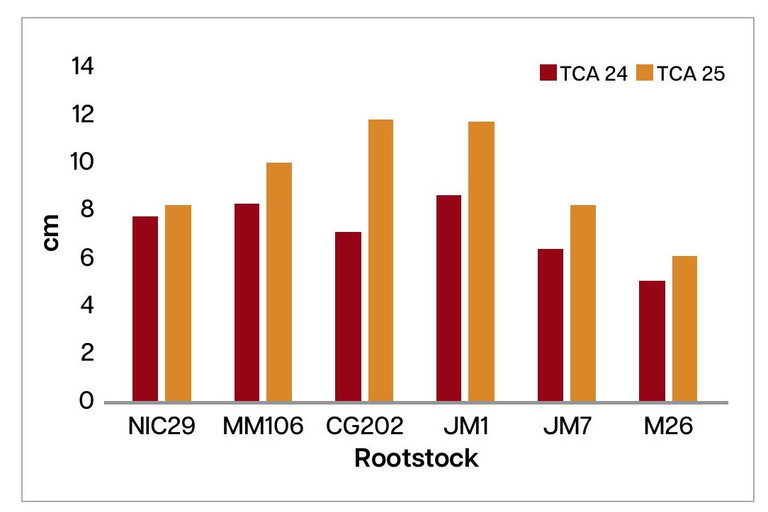POMEWEST profitability
Scorecard serves as a tool to assess
BLOCK PROFITABILITY
Growers from Kirup, Donnybrook, Pemberton and Manjimup attended the APAL Future Orchards Walk Winter Series on Wednesday, 31 July. With fresh, sunny weather it was a pleasure to walk through the orchard at Santa Rita with hosts Terry, Mark and Basil Martella.
Words Susie Murphy White, Project Manager, Pomewest
THE Winter Series featured guest speaker Ben James of Craigmore Sustainables, Jonathan Brookes of AgFirst, and Nic Finger of APAL.
A deep dive into orchard block profitability and strategic planning using the newly introduced Future Orchards Scorecard was the focus for the day.
A tool for transformation
The scorecard, developed by AgFirst Horticultural Consultants, is more than just a checklist, it is a decision-making framework. Growers used it to assess both the overall business and individual blocks, evaluating risks such as frost, hail, irrigation supply, labour availability, and post-harvest partnerships. The goal was to determine whether a block should be improved or removed.
Jonathan Brookes of AgFirst led a compelling session titled “Business and Block Planning — Building the Case for Improvement or Redevelopment.” The group applied the scorecard to the “Lady in Red” block, sparking lively discussion and collaborative scoring. It was a hands-on exercise that got everyone thinking critically about the future of their orchards.
Santa Rita demonstrated great examples of an older, cash-positive block with stable yields, and a younger, netted block with increasing yields but a risk of biennial bearing.
Discussion showed the stable block did not warrant changes or removal, and attention should be focused on the younger block.
Leadership and learning from across the Tasman
Guest speaker Ben James, Business Manager at Craigmore Sustainables in Hawke’s Bay, New Zealand, brought a fresh perspective. Sharing his journey from orchard foreman to business manager, Ben emphasised the importance of empowering staff through tailored learning approaches.
He discussed four different learning styles: visual, reading/writing, kinaesthetic and auditory, and outlined how training resources should include each style to effectively train new staff and ensure instructions are remembered.
Ben uses training videos and a visual priming or job board to outline the day’s tasks, breaking each job into four subtasks. The board includes images of what a good job looks like, and a map of any important locations on the farm.


Ben’s message was clear: orchard success is not just about trees and yields, it is about people. His management style, rooted in continuous learning and staff development, offered a blueprint for sustainable growth.
Rootstock trials: data-driven decisions
Participants also toured the 2022 rootstock trial in the Lady in Red block, comparing six rootstocks: Nic29, MM106, CG202, JM1, JM7 and M26 (see Figure 1). Differences in bud count per trunk cross-sectional area (TCA) provided valuable insights into tree vigour and future block potential, with speculation on how fruit load for 2025 will impact future growth patterns.
The next generation of growers
The southern loop tour welcomed two young growers: Matt Omodei from Pemberton, WA, and Dante Fichera from Goulburn Valley, Victoria. Their enthusiasm and fresh perspectives were a highlight of the day, signalling a bright future for the industry. Matt’s participation in the walk was especially celebrated as a promising sign of youth engagement in WA.

FIGURE 1. Lady in Red rootstock trial planted in 2022, trunk cross-sectional area for 2024 and 2025.
MORE INFORMATION
Thank you to our generous hosts Terry, Basil and Mark Martella of Santa Rita orchard.
Future Orchards Library, Apple and Pear Australia Limited (APAL).
Susie Murphy White, susan.murphy-white@dpird.wa.gov.au